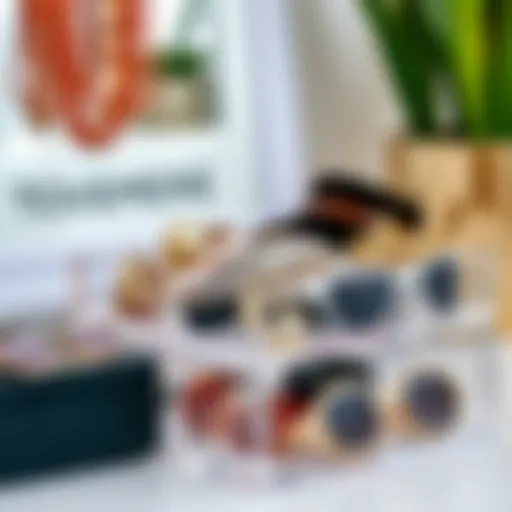The Transformation of Gloves in 1920s Fashion


Intro
The 1920s, often dubbed the "Roaring Twenties," was a decade that stirred the pot of fashion and culture like never before. This era saw a radical shift in societal norms, with women breaking free from the constraints of the previous generations, and one of the most telling signs of this transformation was found in the evolution of gloves. Initially seen as a mark of social status, gloves in the 1920s redefined their role from mere accessories into symbols of personal expression, style, and even rebellion.
While functional in nature, gloves became a vital component of a well-rounded wardrobe. Influenced by significant technological advancements and the rising prominence of Hollywood, designers began exploring new materials and styles that spoke to the carefree spirit of the times. The question loomed, how did these seemingly simple garments manage to reflect such profound societal changes?
By examining the various styles that emerged, the shift in materials used, and the broader socio-economic factors at play, we can unravel the complex narrative behind gloves in this vibrant decade. Let’s delve into the fascinating world of 1920s glove fashion, where every stitch told a story.
Prologue to 1920s Fashion
The 1920s is a decade often regarded as a dramatic shift in fashion – a period of liberation and boldness. This transformation was tied intricately to the socio-economic conditions of the time, alongside cultural movements that shaped the norms of both society and style. Once constrained by formality, fashion began to echo the desires of a people yearning for change, especially after the upheaval of World War I.
Socio-Cultural Context of the 1920s
To understand the fashion of the 1920s, it's essential to dive into the socio-cultural context of this era. Women gained the right to vote in numerous countries, which ignited a wave of empowerment and self-expression. The flapper emerged, symbolizing women's liberation – short skirts, bobbed hair, and, crucially, an array of accessories that completed their looks.
These changes weren't mere superficial shifts; they resonated within communities, altering perceptions of femininity and masculinity. There was a swing towards modernity, fueled by jazz music and a burgeoning consumer culture. Cities buzzed with life, as speakeasies and theaters became social hubs. Gloves, in this context, became more than a necessity; they transformed into a statement of one's modernity, lifestyle, and uniqueness.
As one historian pointed out, "The 1920s were a time when old conventions faded away, making room for fresh styles and identities." Such a statement captures the essence of this vital decade in fashion history.
The Role of Accessories in Fashion
Accessories held an esteemed position in the fashion hierarchy during this decade. Gloves, in particular, served multiple purposes, bridging the gap between functionality and style. They were not simply hand coverings but a canvas for self-expression. The variety in designs—from wrist-length to elbow gloves—allowed individuals to choose according to occasion and mood.
In a world where appearances began to matter more than they had in the previous generations, gloves were carefully coordinated with outfits, lending an air of sophistication.
- Popularity: From elegant luncheons to bustling nightclubs, wearing gloves became synonymous with being fashionable.
- Types: Different materials like kid leather, satin, or lace offered countless options, letting wearers express their personality.
The combination of social upheaval and a renewed appreciation for aesthetics led to the emergence of gloves as essential fashion items. They adorned arms of the ladies who sashayed down city streets, acting as signifiers of her status and sense of style—factors central to understanding the impact of gloves as a fashion statement during the 1920s.
Historical Overview of Gloves
Understanding the historical evolution of gloves during the 1920s is crucial in grasping their transformation from mere utilitarian items to iconic fashion statements. Throughout this decade, societal changes brought about profound shifts not only in how people dressed but also in how accessories were perceived and used. Gloves became emblematic of the era’s daring elegance and its strive towards new freedoms. Fashion wasn’t just about covering oneself anymore; it became a means of self-expression and a reflection of one’s social standing.
By looking back at the history of gloves, we can appreciate how material innovations and changing cultural norms shaped these accessories. This historical perspective enhances our comprehension of the 1920s fashion scene, particularly how gloves, once primarily functional, transitioned into essential style elements that enhanced a wearer’s persona.
From Function to Fashion: The Evolution of Gloves
The journey of gloves from functionality to fashion in the 1920s is a fascinating tale marked by changing perceptions and rising creativity. Initially, gloves served practical purposes – protecting hands from the elements and asserting cleanliness. However, as the decade rolled on, the shift toward more expressive forms saw gloves adorned with embellishments, colors, and patterns, contributing significantly to a person’s overall aesthetic.
During the early part of the decade, gloves were primarily worn by women as a part of their daily attire. They generally consisted of practical materials like leather or cotton, designed to suit everyday needs. Meanwhile, as the Roaring Twenties exploded with new vigor, fashion took center stage. Designers and craftsmen began experimenting with diverse materials like silk and lace, creating gloves that were not just functional but also eye-catching, marking the dawn of a new era in accessory fashion.
By the mid-1920s, gloves had evolved in several notable ways:
- Length: Gloves diversified in length, from wrist-length styles to opulent elbow gloves, each serving a distinct purpose and occasion.
- Designs: The art deco movement infused designs with geometric patterns and striking colors, dramatically shifting how gloves were perceived.
- Occasions: Gloves became obligatory for formal events, representing sophistication and social standing, elevating them to essential components of elegant attire.
More than just covering hands, gloves began to relay messages about personal identity and class status. No longer simply a utility, they became a blank canvas for designers to express innovation, craftsmanship, and the zeitgeist of an era rife with change.
Cultural Significance of Gloves in the Early 20th Century
In the early 20th century, gloves served various cultural significances that transcended their practical uses. Their role in social customs became increasingly important as the 1920s embraced liberation, reflected in both fashion and lifestyle. Wearing gloves hinted at one’s social class, and adherence to certain etiquette was essential, especially among the upper crust.
Gloves were seen as symbols of refinement and civility; thus, they became a staple at social gatherings, emphasizing their status. This era saw numerous societal changes, especially for women, who were gaining more public presence and rights. As women began to assert their individuality, gloves mirrored these shifts. It was common to witness women donning extravagant gloves while participating in social activities or attending public events, further cementing the glove’s status as a social marker.
The emphasis on aesthetics was profound. Colors, embellishments, and intricate designs reflected shifts in identity, rebellion against the Victorian ideals of modesty, and an embrace of modernity. They also became a medium of expression in literature and art, appearing in novels and films, often symbolizing desire, elegance, or societal constraints.
”In a world turned upside down, where women danced to jazz and embraced the spirit of rebellion, gloves were not just an accessory; they were a declaration of independence.”
As fashion incorporated gloves into its lingo, the accessory took on new roles – serving as conversation starters, pieces of art, or even luxuries that flaunted wealth and savoir-faire. This cultural tapestry illustrates how the glove transformed into a nuanced artifact, encapsulating the dreams, aspirations, and realities of a generation poised for change.
Materials Used in 1920s Gloves


The 1920s was a remarkable decade, not only for the bold styles that defined the era but also for the materials employed in fashion accessories like gloves. Understanding the materials used during this time provides insights into the greater changes happening within the fashion industry and society at large. As we peel back the layers, we see how innovative textile production transformed gloves from mere functional items to symbols of status and style.
Emerging Technologies in Textile Production
In the 1920s, textile production underwent significant advancements due to technological innovations. The introduction of new machinery allowed for faster production rates, which meant manufacturers could experiment with a wider array of fabrics. The creation of synthetic materials like rayon, a silk substitute, revolutionized how gloves were made.
Rayon was a game changer; it was not only cheaper but also versatile, allowing for intricate patterns and vibrant colors. This enabled designers to push boundaries, leading to unique glove designs that appealed to the discerning tastes of fashion connoisseurs. Furthermore, these advancements facilitated the mass production of gloves, making them more accessible to various social classes. While gloves were predominantly seen as a luxury item at the start of the decade, by its end, they became more commonplace in everyday fashion.
Common Fabrics and Their Appeal
The selection of fabrics for gloves in the 1920s was diverse, each offering unique qualities that catered to different demographics and occasions. Here are some of the materials popular during the decade:
- Leather: Always a staple, leather gloves signified elegance and durability. They were often made from soft lambskin or deerskin, providing both comfort and class. Women often chose leather gloves for formal events, emphasizing their social standing.
- Silk: Luxurious and lightweight, silk offered a touch of opulence. Gloves crafted from silk were favored for evening wear, complementing glamorous dresses and exuding sophistication.
- Cotton: This fabric appealed to the masses due to its affordability and practicality. While not as extravagant, cotton gloves were common in everyday wear and could be easily washed and maintained.
- Synthetic Fabrics: As noted, rayon and other synthetic materials gained popularity for their cost-effectiveness and versatility, appealing particularly to younger generations who desired fashionable options without breaking the bank.
The trend towards brighter colors and bold patterns matched the roaring spirit of the 1920s. Gloves became not only practical accessories but also expressive pieces that reflected one's personality.
To sum it up, the materials used in the making of gloves during the 1920s were emblematic of the larger social changes happening within the decade. The innovations in textile production allowed designers to carve out space for creativity while simultaneously expanding the glove market. As gloves transitioned into the realm of fashion statements, they reflected the evolving attitudes towards personal style and social status in a rapidly changing world.
"Fashion is not just about clothing; it’s about the little details that tell a person's story. In the 1920s, gloves played a crucial role in that narrative."
For further reading on textile technology and its impact on fashion, you can check sources like Britannica or Wikipedia.
Glove Styles of the 1920s
The glove styles of the 1920s are crucial in understanding how this accessory evolved from something purely functional into a significant fashion statement. The decade was not only marked by the jazz age but also by a flurry of social change, with fashion reflecting both innovation and rebellion against traditional norms. Gloves were no longer mere items to keep hands warm; they became extensions of personality, status, and flair. Designers began to dabble with various styles, pushing boundaries and embracing new materials, which made gloves a centerpiece of many outfits.
Popular Designs: Wrist Length to Elbow Gloves
Popular glove designs during this vibrant decade included a range from wrist-length to elbow gloves, each serving distinct purposes and styles.
Wrist-length gloves became quite the norm for daytime wear, especially among the flapper crowd, who embodied a new liberated spirit. They often crafted these gloves from lightweight materials such as cotton or silk, providing both comfort and an air of sophistication. The juxtaposition of these shorter gloves with the flowing dresses and bobbed hairstyles epitomized a modern woman’s aesthetic, serving as a reflection of newfound freedom and expression.
On the other hand, elbow gloves created a more dramatic statement, frequently chosen for evening events or special occasions. Made from luxurious materials like satin or kid leather, these gloves conveyed an undeniable sense of opulence. There was an elegance to how they caressed the arm, transforming simple evening attire into something spectacularly regal. Worn with the latest flapper dresses, elbow-length gloves added a touch of glam that was hard to miss, a key highlight during social gatherings.
The Influence of Hollywood on Glove Fashion
Hollywood's emerging role as a beacon of fashion during the 1920s profoundly influenced glove styles. As film stars captured public attention, audiences began emulating their fashion choices, and gloves were no exception. Icons like Clara Bow and Joan Crawford adorned their hands with exquisite gloves that dazzled viewers in theaters worldwide. People looked to the silver screen for inspiration, leading to a burgeoning trend that cemented the importance of gloves in everyday fashion. Glove designers embraced this influence, introducing styles that mirrored what was seen in films, effectively turning these accessories into cultural artifacts of the time.
"Gloves became synonymous with glamour, escapism, and the desire for sophistication that resonated with the decade's roar."
Attendees at film premieres and elaborate parties often chose elbow-length gloves to mirror their idols, reinforcing the idea that what one wore on one's hands was just as significant as the clothing itself. From these influences, it became clear that gloves were more than just fabric and seams; they were symbols of status, aspiration, and identity.
Variety in Patterns and Colors
The 1920s also welcomed a rainbow of colors and a plethora of patterns in glove designs, making them even more appealing. Gone were the days of gloves being just black, white, or beige. The decade saw an explosion of vibrant hues: pastel shades for spring, deep jewel tones for elegance, or even daring prints like polka dots and florals. This variety allowed women to coordinate their gloves more closely with their outfits, creating an impeccable look down to the fingertips.
Designers played with texture and print, using bold patterns that reflected the Art Deco aesthetic. From geometric shapes to intricate embroidery, the gloves during this period were proof that accessories could be as exciting as the main attire. This movement towards stylistic variety opened avenues for personal expression, allowing women to showcase their tastes and personalities through their choice of glove designs.
In summary, the glove styles of the 1920s merged practicality with high fashion, showcasing a dynamic transition in society's view of gloves as mere tools of warmth to celebrated fashion statements. Through various lengths, inspirations from Hollywood, and a colorful palette, gloves truly encapsulated the spirit of the era.
Gloves as Status Symbols
The 1920s marked a significant shift in fashion, where accessories came to symbolize not just personal style but also social standing. Gloves, in particular, emerged as critical markers of status among the elite, transcending their practical functions to become symbols of elegance and sophistication.
In the midst of the Jazz Age, the notion of dressing well was not merely about following trends; it was an assertion of identity and wealth. With the rise of luxury goods, gloves became an accessory that spoke volumes about one's lifestyle and taste. A well-crafted pair of gloves could signify access to high-end boutiques, bespoke fashion, and exclusivity. This transformation highlights how gloves were no longer mere items but rather extensions of a person’s social identity.
Access to Luxury and High-End Gloves
During this decade, the glove fashion flourished, echoing the opulence of the time. It wasn’t uncommon for affluent women to own numerous pairs, crafted from the finest materials such as kid leather, silk, or lace. These goods came from esteemed designers who catered to the wealthy elite. A statement was made not just through the style of the glove but also through the pedigree of the brand. For instance, brands like Ellen van Hal or Meyers became synonymous with luxury, crafting gloves that adorned the hands of the socialites and the Hollywood elite.
As a part of this luxury culture, gloves often featured exquisite embellishments, such as beads or embroidery, which were part of the aspirational aesthetic. The choice of glove style, color, and texture served as an accentuation of affluence, with some women even coordinating gloves with their outfits down to the finest detail. This meticulous attention to coordination helped to exhibit not only their fashion sense but their social status.


Beyond functionality, owning high-end gloves was also indicative of leisure—a luxurious life unmarred by the daily grind. Women of privilege could indulge in the beautiful, editable world of fashion while declaring their identity as part of the high society.
Gloves in High Society Events
Gloves were almost a requisite at high society events, establishing a shared language of opulence that attendees could read in a glance. Worn at gala dinners, garden parties, and theater premieres, they became part of the unwritten dress code that dictated elegance.
"At a debutante ball, no self-respecting lady would dare to show up without a matching pair of gloves, as it spoke volumes about one's upbringing and refinement."
Such garments were often donned to signify adherence to social norms surrounding decorum and propriety. Perceptions of elegance were closely tied to how one embodied sophistication through accessories, and gloves were at the forefront of this display. Their presence broke the barrier between casual and formal, offering hints of one’s social engagement and lifestyle choices.
Moreover, gloves served as conversation starters among the elite, showcasing the latest trends that swayed through fashion circles. They were not just accessories but a focal point around which discussions of high fashion revolved. Attendees would linger over the latest styles seen at exclusive events, sharing insights about designer labels and unique details that made each pair remarkable.
In summary, gloves during the 1920s were more than just fashion staples; they were powerful symbols of status that illustrated the socio-cultural dynamics of the decade. They allowed women to navigate social spaces with grace, finesse, and undeniable style.
Impact of Social Changes on Glove Trends
The significance of social changes during the 1920s holds a prominent place in understanding how gloves transitioned from mere practicality to symbols of expression and sophistication. This decade was marked by profound transformations in societal norms, particularly concerning gender roles. Women, invigorated by the suffrage movement, began to embrace newfound freedoms. They navigated public life differently, where garments and accessories became extensions of their evolving identity.
The Rise of Female Empowerment and Fashion Choices
A seismic shift occurred as women started to assert their position in society. With more women entering the workforce and gaining autonomy, the fashion landscape also altered. Gloves became a canvas of self-expression. Soft fabrics, such as satin and silk, along with vibrant hues, became staples for the modern woman, as they sought a balance between elegance and the changing times.
These gloves weren’t just for show— they served as a mark of class and status, signaling confidence and commitment to style. Women began to wear gloves not solely for protection but as essential accessories that conveyed their social standing. This change was embodied vividly at social gatherings where gloves were a must-have, completing a fashionable outfit.
"A lady without her gloves was like a ship without a sail."
The Influence of Economic Shifts
The economic landscape of the 1920s was characterized by fluctuations that directly impacted fashion trends, including glove designs. The post-World War I economic boom led to growth in consumerism. Middle-class women began purchasing stylish gloves, expanding market reach beyond the affluent elite. This increased access spurred creativity among designers.
As young people, especially women, sought independence, gloves adorned with lace, embroidery, and various embellishments were introduced. Along with this, retail environments flourished, accentuating glove fashion as a significant accessory in stores.
In contrast, the latter part of the decade experienced stock market instability, which pushed fashion towards simpler, more functional designs as luxuries became harder to justify. Budgets tightened, and while elegance remained a pursuit, practicality regained its foothold for many. Gloves transitioned once again; their role shifted towards being an accessory for specific occasions rather than everyday adornment.
In sum, the development of glove trends during the 1920s can be closely tied to social progress and economic realities. These accessories not only adorned hands but also reflected wider cultural phenomena, making them a critical point of analysis in the fashion history of the era.
Iconic Designers and Their Contributions
The 1920s was not just a decade marked by radical lifestyle changes; it also witnessed the emergence of fashion designers who would forever alter the landscape of women’s apparel, gloves included. The contributions of influential designers during this period significantly shifted the perception of gloves from mere functional items to essential components of one’s outfit, acting as reflections of personality and status. By examining the works of pioneers like George Barbier and Coco Chanel, one can appreciate how their innovative visions not only defined an era but also set the stage for subsequent fashion evolutions.
George Barbier: Art Deco Influences
George Barbier stood as a titan among designers, beautifully marrying art and fashion with his distinctive Art Deco sensibilities. His flair for employing geometric patterns and bold colors resulted in gloves that were as much a statement as they were accessories. Barbier's designs often incorporated intricate detailing that captured the essence of the roaring twenties, making gloves an indispensable part of the fashionable woman's arsenal.
One of the notable aspects of Barbier's contribution was his hand-painted illustrations, which showcased gloves adorned with stunning embellishments. These bags of creativity attracted the attention of high society and ultimately changed the way gloves were perceived: no longer merely for warmth but as an extension of one's wardrobe.
"Fashion should be a form of escapism, and not a form of imprisonment."
– George Barbier
His designs encouraged women to flaunt their individuality through gloves that ranged from the simple to the extravagant, often featuring patterns infused with floral motifs, lace, and other luxurious elements. The gloves produced under Barbier’s influence were more than just fashion items; they were indeed wearable art.
Coco Chanel: Redefining Women’s Fashion
Coco Chanel is a name synonymous with style, and her impact on gloves in the 1920s is undeniable. Chanel’s ethos was straightforward: simplify. By stripping away the excess associated with previous styles, she redefined elegance for the modern woman.
Through her collections, Chanel introduced gloves that were not overly adorned, yet still chic and fashionable. Silk, leather, and even cotton became commonplace materials for gloves under her guidance. Often paired with her signature little black dress, these gloves complemented women's newfound sense of freedom and confidence, making them an essential accessory for both casual and formal settings.
Chanel’s designs emphasized practicality along with style, which allowed women to express themselves in a more liberated manner. She famously said, "A woman should be two things: who and what she wants." By prioritizing comfort and versatility in her glove designs, Chanel resonated with women wanting to reflect their own identities while embracing the evolving tempo of the decade.
Both Chanel and Barbier, among others, influenced the glove industry by ensuring that these accessories became synonymous with personal style rather than mere functionality. Their contributions played a crucial role in how gloves were perceived and worn, shaping fashion trends that remain relevant today.
Gloves in Popular Culture


The role of gloves in the 1920s transcended mere functionality, carving a niche in the fabric of popular culture. This decade, marked by rapid social change and artistic innovation, saw gloves transforming into symbols of status, elegance, and rebellion. For stylists, designers, and marketers, understanding this intersection of fashion and culture is crucial for gauging how accessories can influence public perception and personal style. Gloves were more than just garments; they acted as extensions of one's personality, reflecting societal shifts and cultural narratives.
Literature and Film References
In the literary and cinematic world of the 1920s, gloves popped up frequently, not just as accessories but as pivotal elements conveying deeper meanings. Authors like F. Scott Fitzgerald, with his novel "The Great Gatsby," often described characters donning chic gloves to signify wealth and sophistication. The imagery of Daisy Buchanan, adorned in her glamorous attire complemented by glossy gloves, speaks volumes of the era's fixation on surface aesthetics and the pursuit of the American Dream.
Films from this period, such as "It” featuring Clara Bow, showcased characters wearing extravagant gloves, which became an essential part of their allure and mystique. These sartorial choices in film not only defined individual characters but also set trends that audiences eagerly adopted, reinforcing the notion of gloves as status symbols. The glove thus became a screen icon—one that stylists of today can understand as part of the broader landscape of fashion's impact on identity in popular narratives.
"Gloves represented a boundary crossed—between the mundane and the magnificent, facilitating a powerful statement of style in an evolving society."
Artistic Expression through Gloves
The artistic realm in the 1920s also embraced gloves as a creative canvas. Art Deco, characterized by its bold geometrics and lavish style, found representation in gloved hands, whether in paintings or theatrical performances. Designers began playing with textures and colors, often using gloves to complement the overall theme of their creations.
Take, for instance, the costume designs for the famous Ballets Russes, where gloves became key components of intricate outfits, expressing femininity through their forms and fabrics. These gloves weren’t merely practical; they became an art form in their own right, pushing boundaries of both fashion and fine art.
Moreover, gloves featured prominently in various art movements, becoming symbols of modernity and sophistication in works by artists like Tamara de Lempicka. The power of gloves in artistic expression echoes relevance today, where modern creators still view fashion choices as essential contributors to storytelling and thematic portrayal.
The Decline of Gloves in Everyday Fashion
The early part of the 20th century saw gloves as an essential component of daily attire. Yet, as the glitzy 1920s wore on, the practicality and necessity of gloves began to fade, making way for a more casual approach to dressing. This decline is significant as it marks a shift in societal norms, fashion preferences, and overall lifestyle. It speaks to how clothing elements reflect broader cultural changes, and in this case, it indicates a move towards informal wear.
Shifts in Attire: The Move Towards Casual Wear
As the decade progressed, societal structures began to relax, leading to a shift in clothing trends. The rise of the flapper culture and jazz music challenged traditional expectations, encouraging women and men alike to express themselves through more relaxed and comfortable clothing.
Tight corsets and formal morning attire took a backseat to dresses with looser fits, and likewise, gloves became less of a wardrobe necessity. The streets became filled with men donning a more casual look, forgoing the once-mandatory gloves that signified social status and refinement.
Casual wear in the 1920s included:
- Dresses without ornate embellishments: Simplicity became a trend, reflecting a desire for comfort.
- Lightweight fabrics: Materials like rayon took center stage, providing ease of movement.
- Hands-free options: Pockets in clothing allowed for convenience, making gloves seem less necessary.
Through these shifts in attire, the overarching vibe of the era shifted toward freedom and self-expression, signaling the diminishing role of gloves in daily dress.
Gloves Transitioning to Occasion-Based Wear
While gloves were losing their prominence as everyday essentials, they did not entirely disappear. By the latter part of the 1920s, gloves transitioned into the realm of special occasions and formal events.
They morphed from a daily accessory into a statement piece, enhancing elegance during gala evenings and societal functions. The festive atmosphere of the era—think jazz parties and champagne soirées—called for refined accessories that added glamour to the outfit, hence gloves remained in favor during these occasions.
"Gloves became the finishing touch to a polished look, transforming into a symbol of sophistication rather than a requirement."
This transformation included:
- Long evening gloves: These were often made from delicate materials such as silk or lace, designed to complement formal gowns.
- Decorative styles: Embellishments, lace trims, and even contrasting colors emerged,
- Subtle statements: A fashionable choice for social butterflies aiming to stand out in crowded dance halls.
As gloves shifted to this occasion-based role, it reflected a broader attitude of selecting clothing and accessories that were no longer just about propriety but about persona and style.
Finale: Legacy of 1920s Gloves in Modern Fashion
The legacy of gloves from the 1920s continues to resonate in today's fashion landscape. This era marked a significant transformation, one that reshaped how we perceive accessories and their role in self-expression. Gloves, once a mere utility, became intricate expressions of identity, aspiration, and social status. As we reflect on this important evolution, several key elements emerge.
Reflections on the 1920s Fashion Movement
The 1920s was a decade that epitomized a break from tradition. Social revolutions and cultural shifts paved the way for women to embrace new liberties, both in lifestyle and fashion. The introduction of short hemlines, bobbed hair, and unapologetically bold fashion statements found a perfect complement in gloves.
Gloves became an essential piece in the ensembles of stylish women, symbolizing sophistication and a newfound independence. Fashion icons of the time showcased elegant designs that were influenced by art movements such as Art Deco. The attention to craftsmanship and detail suggested a whole new era of consumer choices, feeding into the growing desires for individuality and self-expression.
"In the 1920s, a set of gloves could whisper elegance while shouting rebellion against the conventions of the past."
This era not only influenced design but also how people interacted with fashion choices. The sense of community—from flappers to socialites—emphasized a collective identity, where gloves became an essential element, tying together various aspects of style, femininity, and empowerment.
Current Trends Influenced by the Past
Fast forward to present-day fashion, and the echoes of the 1920s are unmistakable. Today, gloves are making a comeback, not just as an item of warmth but as a stylish accessory. Designers draw inspiration from the lavish styles of the past, bringing back the intricate workmanship and vibrant materials that defined glove fashion nearly a century ago.
Some current glove trends that nod to their 1920s predecessors include:
- Wrist-Length Leather Gloves: Pairing them with both casual and dressy wear, they elevate even the simplest outfits.
- Bold Colors and Patterns: Much like the original styles, modern gloves are embracing brightness and bold designs, standing out as accessories rather than mere afterthoughts.
- Layering: Inspired by the layering styles of the 1920s, current designs often feature gloves worn over sleeves or paired with other accessories, creating a reminiscent yet modern look.
These trends emphasize the enduring relevance of gloves, offering a bridge between past elegance and contemporary fashion. The astute fashionista today recognizes that a fine pair of gloves can not only elevate her look but also connect her to the rich history of fashion that shaped women’s roles in society.
Through exploring the evolution of gloves, we see how they encapsulate the broader narrative of fashion. More than just practical items, they are artifacts of social change, reflecting the intersection of style, culture, and personal identity in ways that remain vibrant in modern consciousness. As such, the legacy of 1920s gloves serves not only as a stylistic guide but also as an important chapter in the history of fashion.















